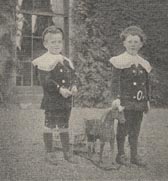Foster Care
Foster Care(1883 - 2004) It was a long held belief in the Waifs and Strays' Society that family life was preferable to institutional life. From this basis its long association with boarding-out and fostering children began. During the second half of the 19th century fostering children was not uncommon. However it was an unregulated and usually fairly local arrangement - which meant that it was sometimes open to the worst forms of abuse. Although the Victorian philanthropist and social reformer Joseph Rowntree had pointed out that 'there is much... mutual helpfulness among the very poor', late Victorian society was scandalised by the actions of the 'baby-farmers'. These were unscrupulous women who undertook to care for young children on the receipt of a lump sum of money, insured the children's lives, and then through neglect or actual harm hurried the children to their deaths. Fostering therefore had a very bad name - and it was a brave move by Edward Rudolf to start boarding out children - even if it was with constant inspection. The first of the Society's children to be boarded-out was a little girl in 1883, who was only the seventh child who had been in their care. Later the Society aimed that all children who were admitted to them under the age of seven would be fostered. As it said in the Society's 1895 Handbook for Workers: 'Not only is a real home provided for the little ones, but also a mother's love. This, many of them, alas! have never known, and it is impossible to overestimate the marvellous effect such a revelation may have in forming their characters.' Children who came into care who were any older than 10 years old would not usually be boarded out. This is probably because they were considered so close to adulthood that the best way the Society could help the children was to train them and provide them with a trade. At first the Society was fairly reliant on the local clergy to help them find potential foster homes and to supervise their charges. As the number of fostered children grew, so did the need to formalise their supervision. In the total of 322 children in the Society's care in 1884 there were 87 children being fostered - the Society's Annual Report of the same year listed the first official supervisors - who would conduct quarterly inspections of the fostered children. In 1893 the first professional Inspectress was appointed, Dr Helen Webb. Throughout the period up to the First World War the number of children the Society boarded out averaged around a quarter of the whole number they were caring for. Many of these children came via receiving homes, such as those in Marylebone, Byfleet, and Clapham Common. These would distribute children to other Society homes, or to thoroughly vetted foster parents, when they first entered the Society's care. The Society continued to arrange the fostering of children well into the 1970s. By the 1980s this was reduced to arranging for the fostering of children with special needs. During the early 2000s the Society's connections with the fostering of children ended. |




